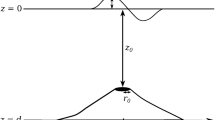Abstract
— We use simple physical models to evaluate and compare the orders of magnitude of the energy generated into a tsunami wave by seismic dislocations and underwater slumps. We conclude that the two sources can generate tsunamis of comparable total energy. However, the slumping source is shown to be fundamentally dipolar in nature, which results in a low-frequency deficiency in the far-field. These simple conclusions corroborate the interpretation of the 1998 Papua New Guinea tsunami as being generated by an underwater slump.
Similar content being viewed by others
Author information
Authors and Affiliations
Rights and permissions
About this article
Cite this article
Okal, E., Synolakis, C. A Theoretical Comparison of Tsunamis from Dislocations and Landslides. Pure appl. geophys. 160, 2177–2188 (2003). https://doi.org/10.1007/s00024-003-2425-x
Issue Date:
DOI: https://doi.org/10.1007/s00024-003-2425-x




